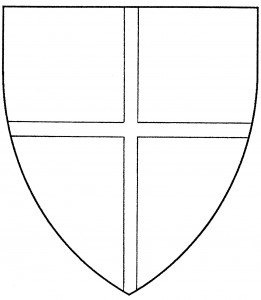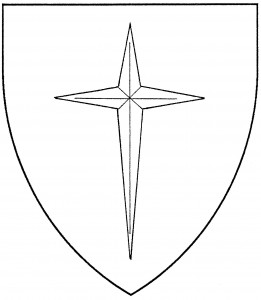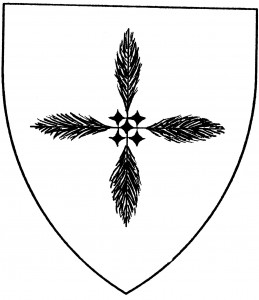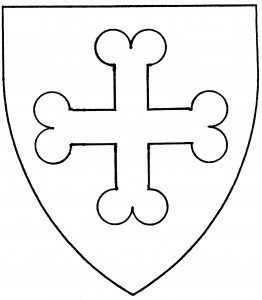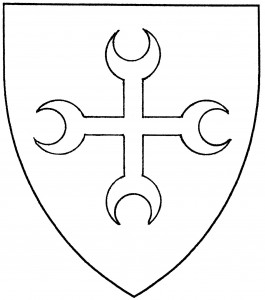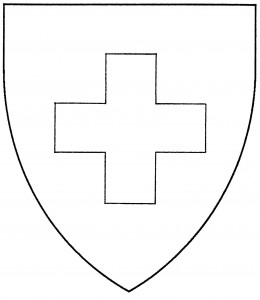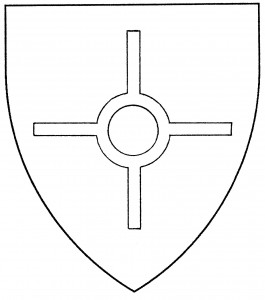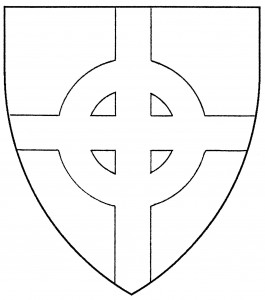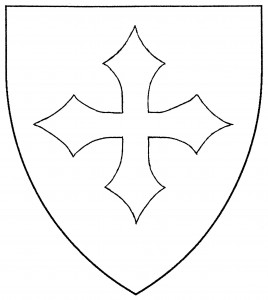The “fillet cross” is said by some modern texts to be the “diminutive” of the ordinary cross. In medieval and Society usage, diminutive terms are only used when there is more than one of the charge in question. The term “fillet” was therefore used in some early Society blazons to denote to the artist that the cross was to be drawn very thin; but no difference was counted. The usage is no longer permitted: the cross’s width, while left to the artist, must be enough to let it dominate the design.
Archives
Cross: Estoile
The “cross estoile” may also be termed a “mullet of four points elongated to base”. It’s a Victorian type of cross, found in Elvin’s Dictionary of Heraldry, 1889 [8:45]; Your Author knows of no examples of its use in period armory.
Eilonwy de Lyur bears: Azure, two flaunches ermine, overall a cross estoile argent.
Cross: Ermine spots
The “cross of four ermine spots” is found as a charge c.1460, in the arms of Hurston or Hurleston [RH; also Legh 36v]. It is sometimes blazoned a “cross erminée” in mundane heraldry; the former blazon should be used, however, to avoid confusion with a “cross ermine” (i.e., an ordinary tinctured of a fur).
Maurya Etain Sableswan bears: Argent, a cross of four ermine spots within a bordure sable.
Mariana Francisco bears: Per bend sinister azure and gules, in canton a cross of four ermine spots argent, a bordure Or.
Cross: Doubly pommeled
Cross: Crosslet
The “cross crosslet” is found as early as c.1280, in the arms of the Earls of Warwick [ANA2 408]. In medieval times, the cross crosslet (so blazoned) could be drawn either as shown, or in the form now termed the cross bottony; the two were considered equivalent emblazons, only artistically different. They are so considered in Society heraldry as well.
A field semy of crosses crosslet may be termed “crusily” or “crusilly”.
William Bekwith bears: Argent, in cross five crosses crosslet sable.
Thomas Langland bears: Per pale argent and sable, a cross crosslet counterchanged.
Griffin Crosthwait bears: Vert crusilly argent.
Cross: Crescenty
The “cross crescenty” was termed un croix à croissants in period French blazons. It’s found in the arms of Tadyngton, c.1445 [DBA3 128].
Gregor of nan Crioch Tuatha bears: Gules, a cross crescenty quarterly Or and argent.
Celestria of Celtenhomme bears as a badge: Purpure, a cross crescenty argent.
Cross: Couped
The “cross couped”, technically speaking, is simply a cross with its ends cut, so that it is not throughout; but it’s conventionally rendered with arms of equal length (cf. the discussion on the cross humetty). The usage is found as early as c.1255, in the arms of Sarren [ANA2 349]. The cross couped in the illustration, with arms as wide as they are long, may also be called a “Greek cross”. Note that the use of a red cross couped on a white background, by itself or in combination with other motifs, has been restricted due to its use as the symbol of the International Red Cross, which is protected by mundane international law.
Edward FitzRanulf bears: Quarterly Or and gules, four crosses couped counterchanged.
Brant Marcksson bears: Per bend sinister argent and vair, in dexter chief a cross couped vert.
Cross: Coptic
The “Coptic cross” is a motif found in Christian art in Ethiopia and Egypt. The term has been applied in modern times to several cross motifs; the illustrated form is the one accepted for Society use. It has not been found in mundane heraldry.
Stephen of Bellamy bears: Argent, a Coptic cross sable within a bordure embattled gules.
Cionaodh na Cairrce mac Cosgraigh bears: Gules, a Coptic cross throughout, a bordure argent.
Passchyer Bisscop bears: Argent, a Coptic cross purpure.
Cross: Coldharbour
The “cross of Coldharbour” was a Society invention when it was first registered; it has since been deemed equivalent to (and blazoned as) a “Celtic cross throughout”. Since it is of the “gunsight” depiction of the Celtic cross, it is no longer permitted.
Henry of Coldharbour bears: Argent, a cross of Coldharbour gules.
Cross: Clechy
The “cross clechy” was originally a variant form of the crosses formy and patonce: it was blazoned a crux florida patens in the Boke of St. Albans, 1485, and used in the arms of da Lisson, mid-15th Century [Triv 201]. Modern heraldry texts sometimes blazon it as a “cross urdy”; in Society blazonry, the latter term is reserved for the cross as an ordinary with a complex line of division.
Teleri Tawel bears: Sable, in chief three crosses clechy Or.
Antonio Giovanni Pecoraro bears: Per pale and per chevron argent and azure, three crosses clechy counterchanged.
